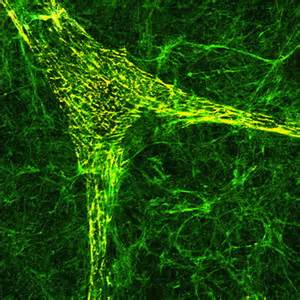Structured extracellular matrix cultured in vitro


ECM (green) groing in agarose molds that force matrix alignment and shape. Credit: Jacquelyn Schell/Brown University
Researchers from Brown University have engineered an extracellular matrix (ECM) without any artificial materials that could prevent using it as an implant. Cells were cultured to originate two kinds of ECM in agarose structures that forced them to grow the matrix in the desired alignment and shape. The recreated ECMs -collagen and elastin- are as strong as the natural ones. The study has been published in the journal Biomaterials.
The ECM is a milieu made of molecules secreted by cells, and it provides them structural and biochemical support. It plays roles in cell adhesion and communication, contributes to regulate cell dynamics and stores growth factors. The characteristics of the ECM can vary depending on the type and proportion of extracellular molecules and on their alignment. In cartilages or tendons, the ECM confers strength and the capacity to stretch. Formation of ECM is crucial in growth and in wound healing, and researchers have long been trying to culture ECM to implant it in patients. The gels, sponges and threads obtained so far from purified ECM proteins generate structures that are too weak to be implanted, lack structure and have poor mechanical properties. Other research groups have tried to solve these problems using artificial elements, but the resultant ECM was not biocompatible.
Molds to force the ECM to grow with proper alignment
Dr. Jeffrey Morgan and his team tried a new technique to grow collagen and elastin, which have strong and elastic properties respectively. They cultured cells in special agarose molds that directed the ECM growth. Instead of sticking to the mold, the cells clumped together and communicated as they would do in the body. The molds were constructed in several shapes and with fixed obstacles that forced the ECM to grow imitating natural structures like tendons. The researchers were able to obtain aligned collagen and elastin. The generated structures were stress-tested and found to be as strong as natural cartilage, skin or blood vessels. The researchers will work now on implementing the ECM structures in patients.
Source: Brown University

